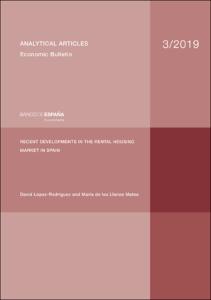Registro completo de metadatos
| Campo DC | Valor |
|---|---|
| dc.contributor.author | López-Rodríguez, David |
| dc.contributor.author | Matea, María de los Llanos |
| dc.coverage.spatial | España |
| dc.date.accessioned | 2020-03-24T07:43:45Z |
| dc.date.available | 2020-03-24T07:43:45Z |
| dc.date.issued | 2019-08-01 |
| dc.identifier.uri | https://repositorio.bde.es/handle/123456789/10784 |
| dc.description | Artículo de revista |
| dc.description.abstract | The proportion of the population living in rental housing in Spain is low compared with the main EU economies. However, in recent years there has been a perceptible rising trend in the relative weight of rental housing in the Spanish residential market. The most significant and dynamic aspects of this development are concentrated in specific groups (essentially young households, immigrants and temporary workers) and specific areas (above all in Madrid, Catalonia, the Balearic Islands and the Canary Islands). One key factor behind the rise in the demand – especially among young households – for residential rentals is the difficulties lower-income groups face in raising their income. This is due to still-high unemployment, the scant duration of new employment contracts and the greater significance of shorter contract hours. The reduction in the average loan-to value ratios of new mortgages, the concentration of economic activity in geographical areas with a rigid supply of residential housing and the tax arrangements associated with housing are other factors that have contributed to a notable increase in demand in the market for residential rentals in Spain. The rise in demand concentrated in specific markets set against a relatively rigid supply of residential rentals in the short term would explain the dynamism of rental prices in these locations. Such robust demand in specific markets has been countered only in part by the increase in private supply following the entry of new professionalised agents in the rental market. Encouraging these new entrants will have been the increase in the gross return on residential rentals in the 2014-2017 period. The diminished buoyancy of supply has come about against the background of the weak public supply of rentals, marked by the emergence of alternative sources for residential housing such as the holiday rental. For a fuller analysis of the residential rental market in Spain, greater socio-demographic and economic information would be needed – including rental prices – at the municipal level or with the greatest geographical breakdown possible. |
| dc.format.extent | 17 p. |
| dc.language.iso | en |
| dc.publisher | Banco de España |
| dc.relation.ispartof | Economic Bulletin / Banco de España, 3/2019 |
| dc.relation.hasversion | Versión en español 123456789/9693 |
| dc.rights | Reconocimiento-NoComercial-CompartirIgual 4.0 Internacional (CC BY-NC-SA 4.0) |
| dc.rights | In Copyright - Non Commercial Use Permitted |
| dc.rights.uri | https://creativecommons.org/licenses/by-nc-sa/4.0/deed.es_ES |
| dc.rights.uri | http://rightsstatements.org/vocab/InC-NC/1.0/ |
| dc.subject | Residential rental market |
| dc.subject | Asking rental prices |
| dc.subject | Housing affordability |
| dc.title | Recent developments in the rental housing market in Spain |
| dc.type | Artículo |
| dc.identifier.bdebib | 000469022 |
| dc.identifier.bdepub | ECBU-2019-3B-art25 |
| dc.subject.bde | Economía urbana y vivienda |
| dc.subject.bde | Fluctuaciones y ciclos económicos |
| dc.publisher.bde | Madrid : Banco de España, 2019 |
| dc.subject.jel | R21 |
| dc.subject.jel | R31 |
| dc.subject.jel | O18 |
| dc.subject.jel | K12 |
| dc.subject.jel | K25 |












